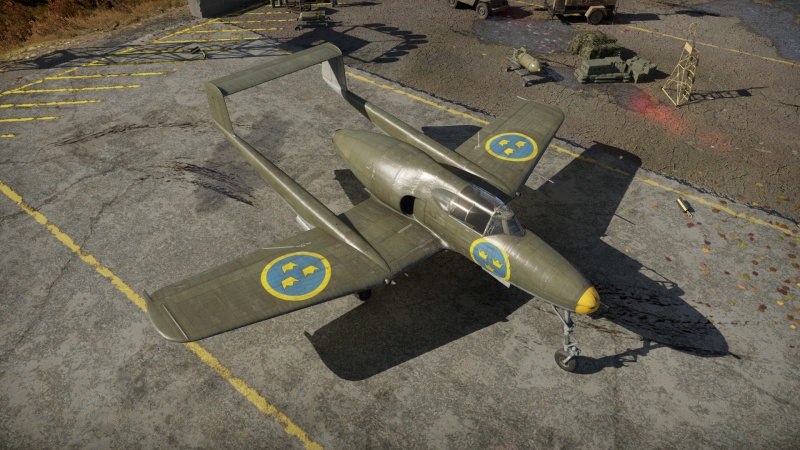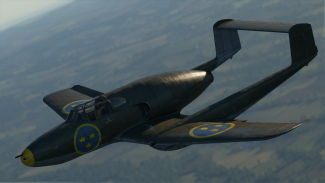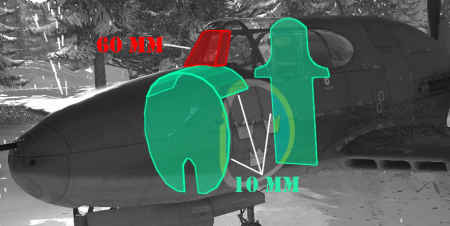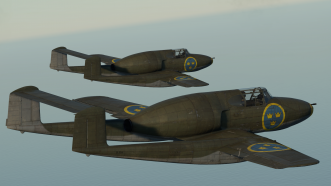J21RA
| This page is about the Swedish jet fighter J21RA. For other versions, see J21 (Family). |
Contents
Description
The J21RA was Sweden's first jet powered aircraft, built on the existing J21 series. The former planes had to be altered a bit due to issues that came with installing a jet engine and would encounter a few issues in the initial stages, but these would later be resolved. It would not be until 10 March 1947 when it would have its first flight. It was less than adequate in a fighter role, but would perform better in an attacker role. The Swedish air force would used these jets between 1949 to 1957, when they would later be replaced by the J29 and A28B.
The J21RA was introduced in Update 1.95 "Northern Wind". As a jet-powered version of the J21, it is the Swedish introduction to jets. Due to equipping a jet engine, the J21RA comes with a higher maximum speed than its predecessor, the J21A-2; it can perform very well in capable hands as a hit and run jet, but it can also perform well if needed in a dogfight. Having a cannon and four heavy machine guns gives it similar firepower to the J21A-2, which is adequate enough to deal with most enemies it will be up against. The J21RA is pretty user friendly, with a lot of ammunition, so mistakes when taking shots are not so costly, but there are also dangers due to it having a habit of easily tearing off its wings at high speeds. Fortunately, it comes with airbrakes that can slow the aircraft down fast enough in case it gets close to these dangerous levels of speed.
General info
The J21RA is a highly manoeuvrable plane, with a good climb rate. The guns, although a downgrade from the previous propeller-driven 13 mm version, still provide enough firepower to down most targets efficiently. The only downside is the airframe, which prevents the aircraft from reaching higher speeds. This is due to the engine being a bit too powerful for the plane, making it common to rip in straight lines and shallow dives. Luckily the J21RA features air-brakes, helping it slow down more effectively, allowing it to fight comfortable at the desired speed range.
The plane is an overall great introduction for anyone looking to learn to fly jet aircraft, as the vehicle handles very similar to its propeller-driven counterpart, while at a much higher speed than before.
Flight performance
The J21RA is distinctly different in looks and performance from all other planes found at the same BR-range. Along with the Yak-15, the Saab 21R is one of the two propeller-driven planes successfully converted into jet propulsion. Just like its Soviet counterpart, the solution comes at the cost of speed. Although a lot more powerful than the J21A-2, it still has the same airframe limitations, resulting in good turn-rate. The climb-rate is also significantly improved due to the weight of the vehicle, resulting in good vertical energy with the ability to stall out slower opponents. Getting back down can prove difficult however, as the J21RA has a rip speed of just 800 km/h, which it can accidentally reach if not careful. To avoid this, the plane features a small set of air-brakes, which aids in maintaining a safe speed. Experienced pilots can find a good use for them, along with the powerful flaps, to force overshoots, or to out-turn propeller-driven opponents. Be careful with the engine however! The propulsion of the J21RA is very primitive, and suffers from fuel starvation during extreme manoeuvres, especially in negative G-loads. This can be fatal when fighting vertically, as the engine drops all power almost immediately, and has to spool back up again before reaching the same efficiency as before.
The flight performance is identical to that of the A21RB, but with slightly less engine power, as the RM1 engine generates some 130 kgf less.
| Characteristics | Max Speed (km/h at 4,000 m) |
Max altitude (metres) |
Turn time (seconds) |
Rate of climb (metres/second) |
Take-off run (metres) | |||
|---|---|---|---|---|---|---|---|---|
| AB | RB | AB | RB | AB | RB | |||
| Stock | 763 | 742 | 25.1 | 25.9 | 18.0 | 17.3 | 850 | |
| Upgraded | 837 | 799 | 23.0 | 24.0 | 24.4 | 21.0 | ||
Details
| Features | |||||
|---|---|---|---|---|---|
| Combat flaps | Take-off flaps | Landing flaps | Air brakes | Arrestor gear | Drogue chute |
| ✓ | ✓ | ✓ | ✓ | X | X |
| Limits | ||||||
|---|---|---|---|---|---|---|
| Wings (km/h) | Gear (km/h) | Flaps (km/h) | Max Static G | |||
| Combat | Take-off | Landing | + | - | ||
| 437 | 408 | 260 | ~11 | ~5 | ||
| Optimal velocities (km/h) | |||
|---|---|---|---|
| Ailerons | Rudder | Elevators | Radiator |
| < 450 | < 390 | < 420 | N/A |
Engine performance
| Engine | Aircraft mass | |||||
|---|---|---|---|---|---|---|
| Engine name | Number | Basic mass | Wing loading (full fuel) | |||
| Svenska Flygmotor RM1 | 1 | 3,550 kg | 192 kg/m2 | |||
| Engine characteristics | Mass with fuel (no weapons load) | Max Takeoff Weight | ||||
| Weight (each) | Type | 6m fuel | 20m fuel | 22m fuel | ||
| 705 kg | Centrifugal-flow turbojet | 3,764 kg | 4,169 kg | 4,262 kg | 5,000 kg | |
| Maximum engine thrust @ 0 m (RB/SB) | Thrust to weight ratio @ 0 m (100%) | |||||
| Condition | 100% | WEP | 6m fuel | 20m fuel | 22m fuel | MTOW |
| Stationary | 1,290 kgf | N/A | 0.34 | 0.31 | 0.30 | 0.26 |
| Optimal | 1,290 kgf (0 km/h) |
N/A | 0.34 | 0.31 | 0.30 | 0.26 |
Survivability and armour
- 10 mm steel - Firewall armour plate
- 10 mm steel - Firewall cover armour plate
- 10 mm steel - Pilot's back armour plate
- 60 mm bulletproof glass
- Engine fire system (EFS)
In terms of protection, the pilot is well protected by metal plates and bulletproof glass. But the pilot's safety isn't the primary concern for the J21RA, as the tail section is incredibly vulnerable. This is due to the twin-boom design, making a tailstrike twice as likely. And since the tail connects to the wing-section, the plane tends to lose tail-control when struck by wing damage. The engine is very large in comparison to the rest of the plane, making it a common target. The J21RA should avoid all possible damage, as surviving large amounts of fire is highly unlikely. Pulling away from head-on engagements increases the survivability immensely. Avoiding the enemy airfield is also important, as the J21RA lacks the speed to keep it safe from flak fire.
Modifications and economy
Armaments
Offensive armament
The J21RA is armed with:
- 1 x 20 mm Akan m/45 cannon, nose-mounted (140 rpg)
- 2 x 12.7 mm Akan m/39A machine guns, nose-mounted (350 rpg = 700 total)
- 2 x 12.7 mm Akan m/39A machine guns, wing-mounted (325 rpg = 650 total)
The J21RA shares the same 20 mm cannon found on the previous J21A-2. This cannon is near identical to the Hispano Mk.V, only with a 30 rpm lower fire-rate. The shells perform the same as on all the other 20 mm-armed jets, making it highly devastating against all types of aircraft. The Armoured targets belt performs favourably with this cannon, as the Air targets belt can cause some mishaps during short bursts. The cannon runs out of ammunition quite quickly compared to the machine-guns, so saving it by only making use of the small calibre guns first can be ideal for spraying.
The J21RA features .50 cal machine guns, being identical to the later American ones. Although a direct downgrade from the Swedish 13 mm previously found on the plane, the J21RA makes good use of these cannons, as they allow for distanced engagements, along with additional firepower to back up the 20 mm cannon. Their ammo count is quite high as well, making them great for strafing, and finishing off heavy bombers.
Usage in battles
- Climb to altitude
- Energy-fight opponents by lowering their speed
- Boom & Zoom people below you
- Dogfight slow targets when necessary
- Fire machine guns and cannons separately to save ammo
Despite being jet-powered, the J21RA still performs best when played like a propeller driven aircraft. The airplane struggles to reach high speeds, and drops it fairly quickly when manoeuvring. So the best use of the new engine is to gain altitude. Although weak in performance compared to earlier jets, the J21RA is decent at climbing to altitude, and can very efficiently deal with targets thanks to the high agility offered at lower speeds. Although the flaps are designed for much lower speeds (similar to the J21A-2), the plane still performs similar to the propeller variant when turning, making them less desired than on other jets.
The best way to start a match is to immediately gain altitude. A height advantage around 5 km is usually ideal to avoid losing vital speed when fighting, as the plane can simply dive to gain more velocity. The best way to handle opponents, is to single them out from their team, and forcing them to dogfight, as the J21RA is too slow to chase anyone down. The J21RA is also efficient against propeller aircraft, as it can comfortably turn-fight, while keeping a higher speed. When paired with the devastating firepower it provides, the J21RA becomes deadly when used properly.
The J21RA can be used in combined battles (Ground RB & Ground SB), but is overall less efficient compared to the A21RB, as it lacks suspended armaments.
Pros and cons
Pros:
- Highly manoeuvrable, competes with propeller driven aircraft
- Familiar layout for seasoned Swedish pilots, same gun placement as previous Saab 21s
- Useful airbrakes, good at avoiding higher speeds
- No wing-tanks compared to the A21RB: Less likely to be set on fire
- Access to modern 12.7 mm rounds, highly efficient at dealing damage
Cons:
- Low top speed, can't reach 800 km/h without tearing off its wings
- Downgraded armament: 12.7 mm machine guns instead of the old 13 mm
- Small fuel tank with limited fuel choice: either 21 or 6 minutes of fuel
- Engine prone to fuel starvation: negative G manoeuvres turn the engine off
- Weaker engine compared to the A21RB
History
The J21RA is a variant of the Saab 21R, a unique early jet fighter developed from the previous Saab 21. The aircraft was one of two semi-successful conversions of propeller fighters into jet fighters, the other being the Soviet Yak-15 (which was converted from the Yak 1/3/7/9 series). The aircraft served as one of the first jet-engined aircraft in Swedish service and was also the first jet-engined-aircraft produced by Saab. The Saab 21Rs were retired in the 1950s with the introduction of more advanced Swedish aircraft.
During WWII, the Saab aircraft production company produced the Saab 21, a fighter aircraft with an unorthodox twin-boom configuration along with a German DB 605B engine. The first such aircraft flew in July of 1943 and entered service soon thereafter. During this time, the Saab firm explored various options for upgrading their Saab 21s, including a variant powered by a Rolls-Royce Griffon engine producing 2000 hp. However, at the same time, the Saab firm was also investigating the possibility of a jet-engined fighter; this led the Saab firm to pursue a jet-engined variant of the Saab 21 for use with the Swedish air force.
In 1947, Saab received the first older J21 airframes for conversion into a jet fighter, designated the J21R; the airframes were extensively modified to house a British-sourced de Havilland Goblin turbojet in place of the DB 605 and its corresponding propeller. Extensive modifications were also made to the aircraft's fuselage, wings and tailplane; notably, the tail section was redesigned so that the elevator would be clear of the jet engine's exhaust. Additionally, the aircraft featured an ejection seat, a novelty at the time.
Initially, a production run of 124 aircraft was planned; however, this was cut to 64 aircraft when the more-advanced J29 Tunnan became available in 1948. The J21RA was the designation given to the first 34 of these aircraft, powered by the Goblin 2 engine, while the J21RB was powered by an indigenously-built Goblin 3 engine. The J21 was retired in the mid-1950s with the introduction of more advanced aircraft such as the Saab 32 Lansen; no original aircraft were preserved but an old Saab 21 airframe was converted to resemble the Saab 21R; this aircraft is displayed at the Swedish Air Force Museum.
Media
- Skins
- Videos
See also
Similar Swedish aircraft
Comparable Aircraft
External links
| Swedish Aeroplane Company Ltd. (SAAB) | |
|---|---|
| Pre-SAAB: SA / ASJA | |
| SA 'Jaktfalken' | J6B |
| SAAB 17 | B17A · B17B · S17BS |
| SAAB 18 | B18A · B18B · T18B · T18B (57) |
| SAAB 21 | J21A-1 · J21A-2 · A21A-3 · J21RA · A21RB |
| SAAB 29 'Tunnan' | J29A · A29B · J29D · J29F |
| SAAB 32 'Lansen' | J32B · A32A · A32A Röd Adam |
| SAAB 35 'Draken' | J35A · J35D |
| SAAB 37 'Viggen' | JA37C · JA37D · JA37DI · JA37DI F21 · AJ37 · AJS37 |
| SAAB 39 'Gripen' | JAS39A · JAS39C |
| SAAB 105 | SK60B · SAAB-105G |
| License Production | B3C (Ju 86K) |
| Export | SAAB-105OE · J35XS · ▄JAS39C · ◔JAS39EBS HU C |
| Sweden jet aircraft | |
|---|---|
| Fighters | J21RA |
| J29A · A29B · J29D · J29F | |
| J32B | |
| J34 | |
| J35A · J35D | |
| JA37C · JA37D · JA37DI · JA37DI F21 | |
| JAS39A · JAS39C | |
| Strike aircraft | A21RB |
| A32A · A32A Röd Adam | |
| A28B | |
| AJ37 · AJS37 | |
| SK60B · SAAB-105G | |
| Export | SAAB-105OE |
| Finland | ▄Vampire FB 52A · ▄MiG-21bis · Saab J35XS |








